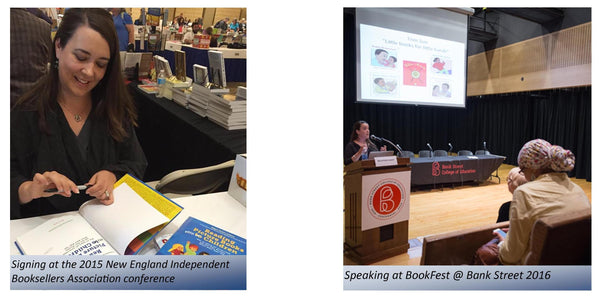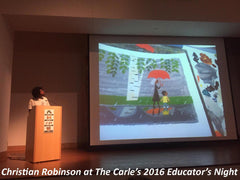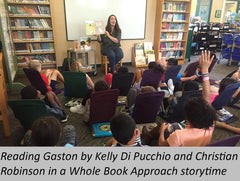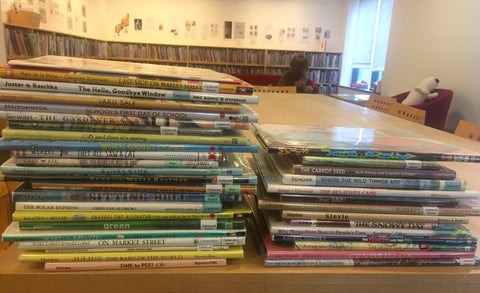Unabridged: a Charlesbridge Children's Book Blog — Yolanda Scott

<br>Happy First Birthday Dear Book!<br> Reading Picture Books with Children One Year Later<p><font size=2>by Megan Dowd Lambert</font></p> 0
 This week marks the one-year anniversary of the publication of my book introducing the Whole Book Approach, Reading Picture Books with Children: How to Shake Up Storytime and Get Kids Talking about What They See, which I wrote in association with The Eric Carle Museum of Picture Book Art.
This week marks the one-year anniversary of the publication of my book introducing the Whole Book Approach, Reading Picture Books with Children: How to Shake Up Storytime and Get Kids Talking about What They See, which I wrote in association with The Eric Carle Museum of Picture Book Art.
The book’s great success has been gratifying, humbling, and very exciting, and I rounded out its first year in the world with a talk at the Book Fest @ Bank Street that applied the Whole Book Approach to books by many of the other speakers who presented there including: Raúl Colón, Christopher Myers, Brian Pinkney, Pam Muñoz Ryan, Jason Chin, Angela Dominguez, Hervé Tullet, my own picture books illustrated by David Hyde Costello and Nicole Tadgell, and various titles from editor Françoise Mouly’s Toon Books imprint. (To see my talk, check out this Kid Lit TV link and go to the 2:05 mark).

Earlier in October I gave a talk at The Carle’s annual Educator’s Night applying the Whole Book Approach to some of the books illustrated by the keynote speaker, Christian Robinson. In preparation for this talk I’d visited local schools and read his books with students, so I got to share their responses to his work with him and the rest of the audience.
 Here Christian is looking at a picture that I’d discussed with kids. The text has Nana say that the tree is “drinking through a straw” and the children read the picture and noticed that the reflection in the puddle makes it look like the tree is going down through the ground into the water, like a straw breaking the surface of the water in a glass. “That’s not what I intended, but I can’t stop seeing it now,” Christian said.
Here Christian is looking at a picture that I’d discussed with kids. The text has Nana say that the tree is “drinking through a straw” and the children read the picture and noticed that the reflection in the puddle makes it look like the tree is going down through the ground into the water, like a straw breaking the surface of the water in a glass. “That’s not what I intended, but I can’t stop seeing it now,” Christian said.
Isn’t that wonderful?
In my Bank Street talk I quoted a line from Reader Response theorist, Louise Rosenblatt, who wrote, “Books do not simply happen to people. People happen to books,” when she described reading as a “transaction” between the reader and a text. It follows that meaning resides, not in the text, but in the space between the reader and the text, and this line of thinking allows us to engage with a book and consider a multiplicity of possible meanings it might provoke depending on what the reader brings to the reading transaction.
Allowing readers to “happen to books” is at the heart of my Whole Book Approach work as I center children’s responses to text, art, and design—the whole book—during storytimes. And, hearing readers’ responses to my book over this past year has been just wonderful. It’s so gratifying to know that teachers, librarians, parents, and other caregivers are reading my book and getting new tools to add to their storytime toolkits as they renew their appreciation for picture books and shore up their passion for reading with children.
Whole Book Approach work as I center children’s responses to text, art, and design—the whole book—during storytimes. And, hearing readers’ responses to my book over this past year has been just wonderful. It’s so gratifying to know that teachers, librarians, parents, and other caregivers are reading my book and getting new tools to add to their storytime toolkits as they renew their appreciation for picture books and shore up their passion for reading with children.
An exciting surprise is that I’ve heard from many artists, writers, an publishing professionals, too. These are people who are already engaged in the creation of picture books and are using my book to augment their knowledge and refine their craft. And, several writers and artists have told me that they’ve used my book to hone storytime skills since visiting schools and libraries to lead book programming has become a big part of their promotional work.
Although I’ve had some readers reach out to me through my website, one of the main ways I’ve heard from people has been through social media. I had never even had a personal Facebook page before this year, but right before Reading Picture Books with Children came out I joined Twitter, and then a few months later I bit the bullet and set up a public author’s Facebook page. I haven’t really taken off with Facebook, but Twitter has been a great way to interact with readers, learn from others in the field, and otherwise immerse myself in a community of people passionate about children’s literature. I am daily grateful for the connections I’ve made there and for the ways it allows me to grow as a writer, a teacher, and a reader.

November 2016 is Picture Book Month, and I will draw upon my book to tweet about picture book art and design. I'll feature new books each day that make the most of design and production elements including: trim size and orientation; jackets and cases; endpapers; front & back matter, typography; and page design elements such as framing, pageturners, and the gutter. Follow along and enjoy!
I have lots of other projects and events on the horizon related to this book, including a guest lecture in a Book Studies course at my alma mater, Smith College, a Skyped Whole Book Approach training with educators in Indiana, and a workshop at a public library in Massachusetts, among other plans. And, of course, I will keep reading picture books with children. I have other writing projects in the works, too—essays, picture book texts, and more Whole Book Approach storytime documentation.
Thanks to everyone who helped make this first year of my book’s publication a success—especially to my readers and to the many people at Charlesbridge, The Carle, and Simmons College who have supported me as I’ve stepped into the role of author. I am hoping my book will appear on lots of holiday shopping lists for teachers, librarians, writers, illustrators, parents and other caregivers (a portion of all royalties goes to support The Carle and you can purchase signed copies through The Carle’s Shop), and I am always eager to hear from readers about their Whole Book Approach experiences.
Happy Whole Book Approach reading to all,
Megan
- Donna Spurlock
- Tags: children's books literacy reading storytime whole book approach Yolanda Scott

Walking a Bridge between Two Worlds: An Interview with Nancy Bo Flood 0
An excerpt from the CBC Diversity blog post on October 5, 2016:
Nancy Bo Flood, author of more than fifteen books, sat down with her editor, Yolanda Scott, to discuss Soldier Sister, Fly Home, out from Charlesbridge in August 2016.

YS: You often mention “walking a bridge between two worlds or cultures,” and you’ve said that’s what Tess does in the Soldier Sister, Fly Home. What do you mean?
NBF: Soldier Sister, Fly Home is about walking the bridge between two worlds, Navajo and Anglo, and also the bridge between three generations: one’s own, one’s parents’, and one’s grandparents’. The two sisters, Tess and Gaby, are bi-racial. They walk several bridges daily, between different cultures and different generations. Many of us do this, to different degrees and at different times in our lives.
. . .
YS: You and I were talking about your book, and you told me about a time that Tim Tingle, Choctaw, said that one can never really know another culture, but that shouldn’t stop anyone from sharing their perspective. Can you say more about what you think he meant and how you’ve incorporated this notion into writing your book?
NBF: “Let us meet on the bridge.” This idea was central in a talk given by Tim Tingle, Choctaw, several years ago at the Tucson Book Festival. Tim spoke about writing and sharing stories and emphasized that “One can never ‘know’ another culture, just as one can never completely understand the experiences of another generation. But that should not stop us from sharing our perspective.”
I also think that sharing one’s perspective is important and valid. That’s how we learn from each other and how we begin to care about others. I believe that although cultures differ, the human heart does not. As children or adults, students or parents, we share common struggles, yearnings, joys, and sorrows. Participating, listening, sharing heartaches as well as stories is how we come to know each other. So over the years as I taught at Diné (Navajo) College, I learned as I comforted fussy babies, helped grind corn for a girl’s coming-of-age ceremony, sat in rodeo stands as mothers watched their youngsters race around barrels or cling to the backs of bucking bulls. And then as mothers we talked. We shared from the heart. I sat with students after class as they worried about discrimination, being bullied, about frustrations with parents and grandparents. I listened. I did my best to share what I heard.
To read more of this discussion, please visit: http://www.cbcdiversity.com/post/151438543403/walking-a-bridge-between-two-worlds-an-interview

As a fish-brain surgeon or a rodeo poem wrangler, Nancy Bo Flood has always loved stories. She strongly believes that words—in poetry or prose—help heal our hearts and give us new eyes to see the world. Nancy was first a research psychologist studying brain development at the University of Minnesota and London University before following her passion: writing for children.
Yolanda Scott is associate publisher and editorial director at Charlesbridge, where she has edited nearly 200 books since beginning her career in 1995. She is a co-founder of Children’s Books Boston, sits on the board of directors of the Children’s Book Council, and is a former member of the CBC Diversity Committee.
- Cindy Ritter
- Tags: CBC Diversity Nancy Bo Flood Soldier Sister Fly Home Yolanda Scott



